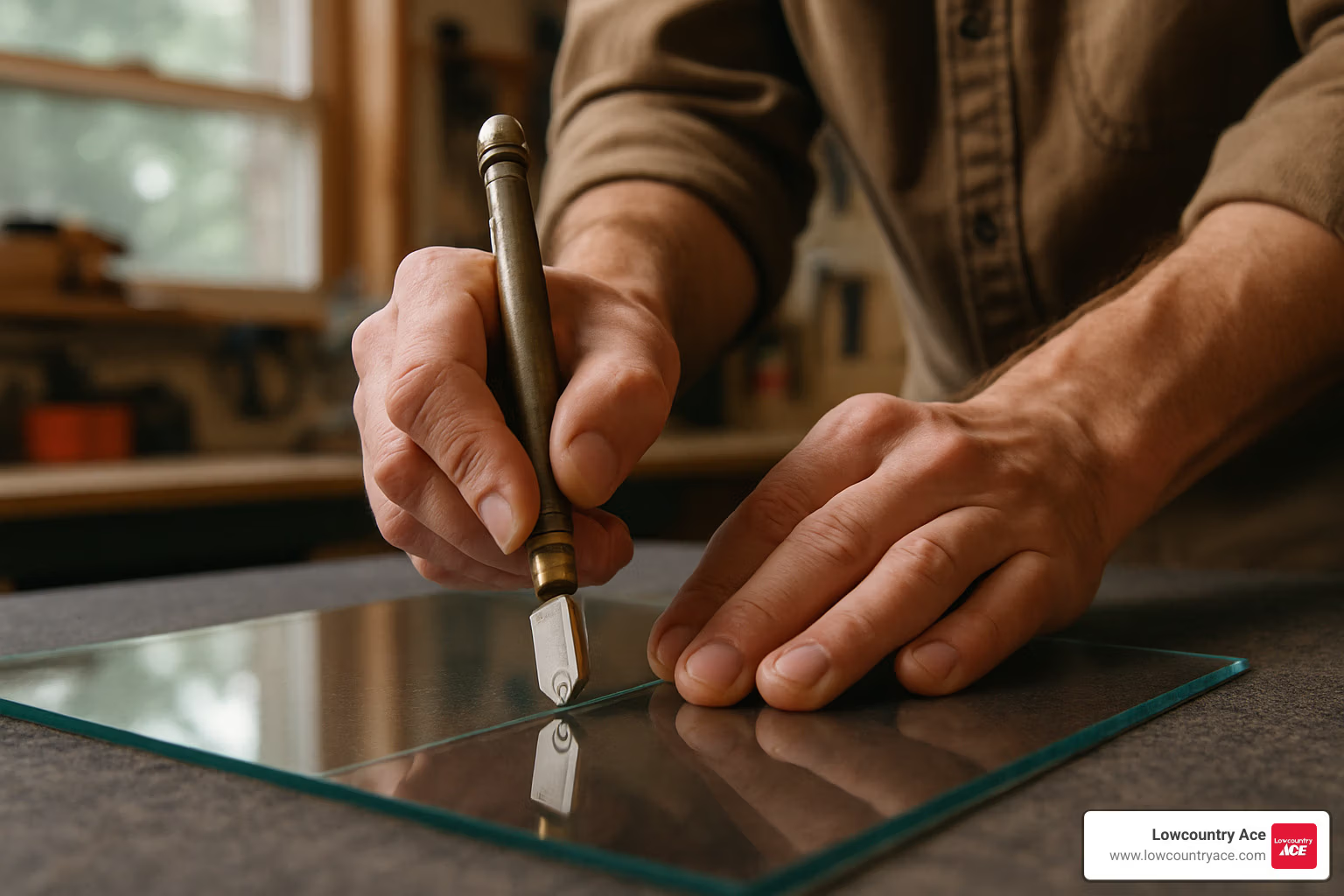Ace Hardware Glass Cutting Tool: Top 3 Powerful Picks 2025
Why Ace Hardware Glass Cutting Tools Are Perfect for DIY Projects
Whether you’re fixing a picture frame or replacing a cabinet shelf, ace hardware glass cutting tool options provide reliable solutions for home projects. Based on customer feedback and product availability, Ace Hardware offers both affordable manual cutters and professional-grade tools to meet different skill levels and budgets.
Top Ace Hardware Glass Cutting Tools:
• Fletcher-Terry Steel Wheel Cutter – $5.99, perfect for beginners
• Oil-Fed Carbide Cutters – Professional precision with self-lubrication
• Plexiglass Scoring Knives – Specialized for acrylic materials
• Running Pliers & Accessories – Essential breaking and finishing tools
Ace Hardware also provides in-store glass cutting services for plexiglass and non-tempered glass, allowing customers to get custom dimensions cut while they wait. This combination of DIY tools and professional services makes Ace a one-stop solution for glass projects.
One forum user shared their experience: “I had my refrigerator shelf shattered and was replaced perfectly with plexiglass cut at Ace Hardware… great price and service.” This reflects the quality and convenience customers can expect.
The helpful team at Lowcountry Ace has extensive experience guiding customers through glass cutting projects, from selecting the right ace hardware glass cutting tool to providing safety tips and cutting demonstrations. With both retail expertise and hands-on project knowledge, they help ensure your glass cutting success.
Essential ace hardware glass cutting tool terms:
– ace hardware cut glass to size
– ace hardware mirror cutting
– how much does ace hardware charge to cut glass
How Glass Cutting Tools Work: From Score to Snap
If you’ve ever wondered how a simple ace hardware glass cutting tool can slice through glass so cleanly, the answer lies in a clever technique called score-and-snap. It’s actually quite fascinating once you understand what’s happening beneath that tiny cutting wheel.
When you drag a glass cutter across the surface, you’re not actually cutting all the way through the glass. Instead, the scoring wheel creates a microscopic crack that goes about 10% of the way into the glass thickness. Think of it like perforating paper – you’re creating a weak point where the glass wants to break.
The magic happens when you apply pressure along that score line. The glass follows the path of least resistance and snaps cleanly along your predetermined line. It’s physics in action, and it works beautifully when done right.
The scoring wheel material makes a big difference in your results. Steel wheels are the budget-friendly option and work perfectly fine for basic window glass projects around the house. Carbide wheels stay sharp much longer and create those satisfying, clean scores that make you feel like a pro. For the ultimate precision, diamond wheels are available on high-end tools, though most DIYers find carbide more than adequate.
Here’s something many beginners don’t realize: oil lubrication is absolutely crucial for good cuts. The oil reduces friction between the wheel and glass, keeps glass particles from dulling your wheel, and helps create that smooth score line you’re after. Professional cutters often have built-in oil reservoirs that automatically keep the wheel lubricated – no more forgetting to apply oil and wondering why your cuts aren’t clean.
Plexiglass and acrylic materials play by slightly different rules. These plastics need a specialized scoring knife with a sharp blade rather than a wheel. The blade creates a deeper groove that allows for clean snapping without the spider-web cracking that regular glass cutters can cause on these materials.
Key Features to Look For
When you’re shopping for an ace hardware glass cutting tool, certain features separate the tools that make you smile from the ones that make you frustrated.
Wheel material tops the list of important considerations. While carbide wheels cost more upfront, they maintain their sharpness significantly longer than steel wheels. If you’re planning more than just an occasional repair, the extra investment pays off in consistently clean cuts and less wheel replacement.
Handle ergonomics might seem like a small detail, but your hands will thank you during longer projects. Look for tools with cushioned grips and balanced weight distribution. The handle should feel secure without requiring a death grip – if your hand cramps up after a few cuts, you’ll struggle with accuracy.
A built-in oil reservoir transforms the cutting experience from good to great. These self-lubricating cutters eliminate the guesswork and ensure every score gets proper lubrication. No more dry scoring that chips or cracks your glass at the worst possible moment.
Finally, consider the cutting thickness range your projects require. Basic cutters handle standard window glass from 1/8″ to 1/4″ thickness beautifully. If you’re tackling thicker architectural glass up to 1/2″ or planning more ambitious projects, investing in a professional-grade tool makes sense.
The helpful team at Lowcountry Ace can guide you through these features and help match the right tool to your specific projects and skill level.
Ace Hardware Glass Cutting Tool Lineup
Walk into any of our Lowcountry Ace locations in Charleston, James Island, or Folly Beach, and you’ll find a thoughtfully curated selection of glass cutting tools that actually work. We’ve learned over the years that not all cutters are created equal, so we focus on brands like Fletcher-Terry that have earned their reputation through consistent performance.
The ace hardware glass cutting tool selection at our stores ranges from budget-friendly options under $10 to professional-grade carbide cutters that’ll handle years of regular use. We stock what our customers actually buy and use successfully in their projects.
What sets our tool lineup apart is the practical experience behind our recommendations. The helpful team at Lowcountry Ace has tested these tools on real projects and can tell you exactly what works best for your specific needs.
| Tool Type | Price Range | Best For | Key Feature |
|---|---|---|---|
| Fletcher-Terry Steel Wheel | $5.99 | Beginners, occasional use | Simple, reliable design |
| Oil-Fed Carbide Cutter | $25-45 | Regular use, precision work | Self-lubricating system |
| Plexiglass Scoring Knife | $8-15 | Acrylic materials | Specialized blade design |
| Running Pliers | $12-20 | Clean breaking | Controlled pressure application |
Fletcher-Terry Steel Wheel Cutter: ace hardware glass cutting tool Under $10
At just $5.99, the Fletcher-Terry Steel Wheel 4-inch cutter proves you don’t need to spend big money to get clean glass cuts. This little workhorse has been helping DIYers tackle everything from picture frame repairs to small window replacements for years.
The steel wheel design keeps things simple and effective. There’s no complicated oil reservoir to maintain or expensive carbide wheel to worry about damaging. Just score and snap – it’s that straightforward.
We particularly recommend this cutter for anyone just starting out with glass cutting. The 4-inch size fits comfortably in most hands, and the fixed blade design eliminates any guesswork about wheel positioning. Plus, with our free 30-day returns, you can try it risk-free on your project.
One thing that surprises customers is how long these steel wheels actually last with proper care. We’ve had hobby stained glass makers use the same Fletcher-Terry cutter for multiple years without needing a replacement.
Oil-Fed Carbide Cutter – Pro Precision
When you’re ready to step up your glass cutting game, oil-fed carbide cutters represent a significant leap in both convenience and performance. These professional-grade tools eliminate the mess and hassle of manual oil application while delivering consistently cleaner cuts.
The carbide wheel technology is where these cutters really shine. Carbide stays sharp dramatically longer than steel – we’re talking about 5 to 10 times the lifespan. That means fewer interruptions to replace wheels and more consistent scoring throughout your project.
The self-lubricating system automatically applies cutting oil as you score, ensuring optimal performance without the sticky fingers and messy workspace that comes with manual oiling. This feature alone makes these cutters worth the investment for anyone doing regular glass work.
What really impresses customers is how much less pressure these carbide wheels require. The superior sharpness means you can achieve clean score lines with a lighter touch, reducing hand fatigue and minimizing the risk of glass breakage during cutting.
Specialty Plexiglass Scoring Knife
Cutting acrylic materials like plexiglass and Lexan requires a completely different approach than traditional glass cutting. Our specialty scoring knives feature sharp, replaceable blades specifically engineered for these synthetic materials.
The key difference lies in the cutting technique. While glass benefits from a single firm score, acrylic materials respond better to multiple light passes with gradually increasing pressure. This creates a deep groove that allows clean snapping without the stress fractures that plague improper technique.
These lightweight handles reduce hand fatigue during extended cutting sessions, which is especially important when working with larger sheets of plexiglass. The blade design prevents the melting and chipping that can occur when using inappropriate tools on acrylic materials.
Must-Have Accessories & Replacement Parts
Even the best ace hardware glass cutting tool needs proper support accessories to deliver professional results. We stock everything you need to complete your glass cutting setup successfully.
Cutting oil might seem like a small detail, but it makes a huge difference in cut quality and wheel longevity. Replacement wheels in both steel and carbide options ensure your favorite cutter stays productive for years. Running pliers and breaking pliers provide the controlled pressure needed for clean breaks without the stress concentrations that cause unwanted fractures.
Don’t overlook straightedge guides for achieving perfectly straight cuts. A wobbly score line almost guarantees a poor break, no matter how good your cutter is. We also carry essential safety equipment including protective glasses and cut-resistant gloves.
Running pliers deserve special mention because they’re often the missing piece in DIY setups. These specialized tools grip both sides of the score line and apply controlled breaking pressure exactly where you need it. They’re particularly valuable when working with narrow strips or delicate pieces where hand breaking becomes impractical.
For all your project needs beyond glass cutting, check out our comprehensive Home Improvement Supplies selection.
Choosing the Right Cutter & Safe Best Practices
Working with glass can be incredibly rewarding, but safety always comes first when using any ace hardware glass cutting tool. The good news is that with proper preparation and technique, glass cutting becomes a straightforward and enjoyable skill.
Before you make your first score, gather your essential safety gear. Eye protection is absolutely non-negotiable – even tiny glass chips can cause serious eye injury. A good pair of work gloves provides grip and protects your hands from sharp edges. You’ll also want a flat work surface covered with carpet or felt to cushion the glass and prevent scratching.
Good lighting makes all the difference in seeing your cutting line clearly. Position your work area near a window or under bright overhead lights. A stable table that can support your entire glass piece without any overhang prevents unexpected breaks that can ruin your project.
The most common mistake beginners make is applying too much pressure during scoring. You’re not trying to cut through the glass – just create a controlled fracture line. Steady, consistent pressure in a single pass works much better than multiple light passes or excessive force.
Never attempt to cut tempered glass with hand tools. This safety glass is designed to shatter completely when its surface is compromised, making it impossible to cut safely at home. When in doubt about glass type, ask the helpful team at Lowcountry Ace for guidance.
For comprehensive information about our glass cutting services and additional safety tips, check out More info about Ace Hardware Glass. You can also find helpful community discussions at Glass cutting @ Ace Hardware.
Regular Glass vs. Plexiglass: Tool & Technique Differences
Understanding the differences between cutting regular glass and acrylic materials saves time, money, and frustration. Each material has its own personality and responds differently to cutting techniques.
Float glass – the standard window glass used in most home projects – cuts beautifully with traditional wheel-type cutters. The key is one firm scoring pass with proper oil lubrication, followed by an immediate clean snap. The glass wants to break along your score line, so let it do the work.
Tempered glass presents a different challenge entirely. This safety glass undergoes special heat treatment that makes it incredibly strong but impossible to cut once processed. If you accidentally try to score tempered glass, it will shatter into thousands of small pieces. Always verify your glass type before beginning any cutting project.
Acrylic materials like plexiglass and Lexan require a completely different approach. Instead of a wheel cutter, you’ll need a specialized scoring knife with a sharp blade. The technique involves multiple light passes, gradually increasing pressure to create a groove about one-third the thickness of the material.
The blade angle matters significantly with acrylics. Maintain a consistent angle throughout your cut to ensure uniform groove depth. Unlike glass, acrylic tolerates – and actually benefits from – multiple scoring passes to build up the groove gradually.
Edge finishing differs between materials too. Glass edges can be smoothed with fine sandpaper, while acrylic edges often benefit from filing followed by progressive sanding with finer grits for a polished appearance.
First Cut Success: Using an ace hardware glass cutting tool Step-by-Step
Success with your ace hardware glass cutting tool starts long before you touch glass to cutter. Proper preparation and technique turn what seems like magic into a reliable, repeatable process.
Measure twice, cut once isn’t just an old saying – it’s essential wisdom for glass cutting. When cutting glass for picture frames or cabinet shelves, subtract about 1/8 inch from each dimension. This small gap allows for thermal expansion and makes installation much easier.
Mark your cutting line with painter’s tape rather than just a pencil mark. The tape prevents chipping along the cut edge and gives your cutting wheel a clear path to follow. It also helps prevent the wheel from wandering if your hand wavers slightly during scoring.
The actual scoring technique determines your success. Position your cutter at the far edge of the glass and draw it toward you in one smooth, continuous motion. Listen to the sound – it should be consistent throughout the cut. A grinding or skipping sound means you need to adjust your pressure or check your wheel condition.
Snapping requires confidence and proper technique. Position the score line directly over your table edge and apply firm downward pressure on both sides simultaneously. The glass should break cleanly with a satisfying snap. For narrow strips under two inches wide, running pliers provide much better control than trying to snap by hand.
Sand those edges immediately after cutting. Fresh-cut glass edges are razor-sharp and can cause serious cuts. A few passes with fine sandpaper or a sanding block creates safe, smooth edges that won’t snag or cut during handling.
The helpful team at Lowcountry Ace has guided countless customers through their first successful glass cuts. Don’t hesitate to ask for a demonstration or safety tips – we’re always happy to help ensure your project succeeds safely.
Maintenance & Storage for Long-Lasting Performance
Taking care of your ace hardware glass cutting tool is like maintaining any quality tool – a little attention goes a long way toward keeping it performing like new. The helpful team at Lowcountry Ace often reminds customers that proper maintenance can extend tool life by years, not months.
Keeping your cutting wheel clean makes the biggest difference in performance. After each cutting session, simply wipe the wheel with a clean cloth to remove those tiny glass particles that love to stick around. These little troublemakers can make your next cut skip or create jagged score lines that nobody wants to deal with.
For stubborn buildup that won’t wipe away easily, a soft brush dipped in mineral spirits works wonders. Just remember to let everything dry completely before your next project – wet wheels and glass don’t play well together.
Oil maintenance keeps self-lubricating cutters running smoothly. Check the oil level before starting any major project, and top it off when needed. Here’s a pro tip from our Charleston location: only use cutting oil designed specifically for glass tools. Regular household oils might seem like a good substitute, but they can gum up the works over time.
Living in our beautiful but humid Charleston area means rust prevention deserves extra attention. A light coating of cutting oil on metal surfaces creates a protective barrier against moisture. It’s especially important during our steamy summer months when humidity seems to get into everything.
Smart storage protects your investment from unnecessary damage. Keep your tools in a protective case or dedicated drawer where they won’t bang against other items. Those delicate cutting wheels can chip or dull from something as simple as knocking against a screwdriver.
Knowing when to replace wheels saves frustration and improves results. Steel wheels typically handle about 1,000 to 2,000 linear feet of cutting before showing their age. Carbide wheels are the marathon runners of the cutting world – they can go 5 to 10 times further before needing replacement.
When your cuts start skipping or the score lines look rough instead of clean, it’s time for a new wheel. Don’t try to push a worn wheel beyond its limits – fresh cuts are worth the small investment in replacement parts.
Frequently Asked Questions about Ace Hardware Glass Cutting Tools
Does Ace Hardware offer in-store glass cutting services?
Absolutely! Our Lowcountry Ace locations provide professional in-store glass cutting services for both plexiglass and regular glass. You can bring in your measurements and have custom pieces cut while you wait – no need to wrestle with tools or worry about making mistakes on expensive materials.
The helpful team at Lowcountry Ace has years of experience handling precise cuts for everything from replacement refrigerator shelves to custom picture frames. We work with plexiglass, acrylic, and non-tempered glass up to certain thicknesses, ensuring you get exactly what you need for your project.
One satisfied customer shared their experience: “I had my refrigerator shelf shattered and was replaced perfectly with plexiglass cut at Ace Hardware… great price and service.” This kind of feedback reflects our commitment to quality cuts and fair pricing.
Whether you’re working on a craft project, need a replacement shelf, or want professional precision for a home repair, our cutting service saves you time and ensures perfect results. Just bring your measurements to any of our Charleston, James Island, or Folly Beach locations.
What’s the safest way to cut tempered glass?
Here’s the straightforward answer: never attempt to cut tempered glass with any hand tool, including any ace hardware glass cutting tool. This isn’t just a suggestion – it’s a safety imperative that could save you from injury and frustration.
Tempered glass undergoes a special heating and cooling process that makes it 4-5 times stronger than regular glass. However, this same process creates internal stresses that make the glass impossible to cut safely. Any attempt to score tempered glass will cause it to shatter completely into thousands of small, relatively harmless pieces.
You can identify tempered glass by looking for a small etched mark in one corner that says “tempered” or by the way it sounds when tapped – it has a higher pitch than regular glass.
If you need custom-sized tempered glass, it must be cut to size before the tempering process. Contact a professional glass fabricator who can cut the glass to your specifications and then temper it. This is the only safe and effective way to get custom tempered glass pieces.
Can I get replacement wheels and oil at Ace?
Yes, we keep our glass cutting tool users well-supplied! Our Lowcountry Ace locations stock replacement wheels for the most popular glass cutter models, along with specialized cutting oil and other essential accessories.
We carry both steel and carbide replacement wheels to match whatever ace hardware glass cutting tool you’re using. Steel wheels are perfect for occasional users, while carbide wheels offer the longevity that frequent glass cutters appreciate. Our cutting oil is specifically formulated for glass cutting tools – not just any household oil that might gum up your cutter’s mechanism.
The helpful team at Lowcountry Ace can help you identify exactly which replacement parts your specific cutter needs. We know it can be confusing with different wheel sizes and thread types, so we’re happy to take a look at your tool and make sure you get the right fit.
We also stock running pliers, straightedges, and safety equipment to round out your glass cutting setup. Having everything available locally means you can tackle your project without waiting for online orders or making multiple trips to different stores.
Conclusion
Choosing the perfect ace hardware glass cutting tool comes down to understanding your specific needs and matching them with the right equipment. Whether you’re tackling your first picture frame repair or working on multiple home projects, having the right tool makes all the difference between frustration and success.
For occasional DIYers, the Fletcher-Terry steel wheel cutter at $5.99 delivers remarkable value. It’s proof that you don’t need to spend a fortune to get clean, professional-looking cuts. On the other hand, if glass cutting is becoming a regular part of your projects, investing in a carbide wheel cutter with oil-fed precision will save time and deliver consistently better results.
The beauty of shopping at Lowcountry Ace is that you’re not just buying a tool – you’re getting access to local expertise. The helpful team at Lowcountry Ace understands that every project is different, and they’re genuinely excited to help you succeed. Whether you need guidance on choosing between a steel or carbide wheel, want to learn proper scoring technique, or prefer to use our in-store glass cutting services, we’ve got you covered.
Safety and preparation are just as important as the cutting tool itself. Taking time to set up properly, wear protective equipment, and practice good technique will keep you safe and ensure your projects turn out exactly as planned.
Our Charleston, James Island, and Folly Beach locations keep a full selection of glass cutting tools and accessories in stock, so you can get everything you need in one trip. From replacement wheels and cutting oil to running pliers and safety gear, we make sure you have everything for successful glass cutting.
For complete details about our glass cutting services and tool selection, visit: More info about Ace Hardware Glass
Stop by our Riverland Market location on Folly Road or any of our Lowcountry Ace stores to see our complete ace hardware glass cutting tool selection firsthand. Our knowledgeable staff is always ready to help you choose the perfect tool and share tips that will make your next glass cutting project a complete success.
Lowcountry Ace Hardware: Your one-stop shop for home improvement. We offer quality products from trusted brands and expert advice from our experienced staff. Located on James Island, visit us for tools, hardware, fishing gear, power tools, building materials, grills & smokers, electrical and plumbing supplies, and more.

















